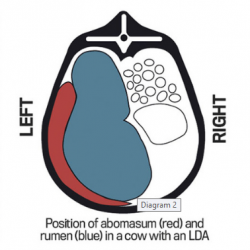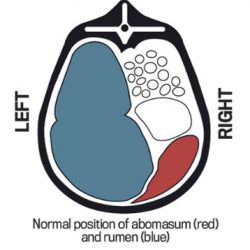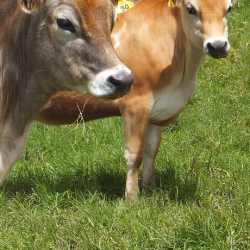Left Displaced Abomasum (LDA) In Dairy Cows
Do you ever get those cows who just slowly drop of their milk after calving and gradually lose condition? If so they could have an LDA…
What is an LDA?
The abomasum is a cow’s fourth stomach. It is the “true stomach” and looks a little bit like a dog or human stomach. It normally sits on the floor of the abdomen slightly to the right hand side.
In certain conditions the abomasum fills with fluid and gas and moves under the rumen (the large first stomach) to sit between the rumen and left side of the cow, this is a “Left Displaced Abomasum” or LDA.


(picture from https://www.fginsight.com/vip/vip/handy-hints-how-to-detect-and-deal-with-ldas-10163)
Which cows get LDAs?
- Almost exclusively a disorder of high producing adult dairy cows.
- Most commonly occurs in the first month after calving.
- Uncommon in exclusively pasture fed animals.
- The incidence of LDAs increases considerably with the amount of concentrate in the diet.
- In Victorian dairy farms it affects approximately 1 in 100 dairy cows. It is much less frequently diagnosed in New Zealand but this in part is likely to be due to a lack of awareness and detection of these cases.
- Much less likely in cows which have received a good transition diet prior to and at calving.
Cows who have reduced feed intake for other reasons such as cows with retained membranes, dirty cows, or those with mastitis are more prone to developing an LDA.
What symptoms will my cow show?
- Usually affects cows within 4-6 weeks of calving.
- There is often a gradual decrease in milk production, but occasionally a rapid drop.
- Cows will have reduced appetite, and in particular eat less concentrates.
- They have often been treated for ketosis a few days earlier, or have signs of ketosis (some people can detect this as a “pear drop” smell to the breath).
- They might have reduced, pasty faeces, or diarrhoea.
- They might have slightly sunken eyes.
How can an LDA be diagnosed?
Call your vet and we will come out and examine the sick cow. There are a number of factors that can indicate an LDA is likely but the main sign is hearing a high pitched “ping” over the ribs on the left hand side of the cow when we listen with a stethoscope and flick the ribs at the same time.
Can an LDA be treated?
Yes! There are a number of different treatment options, including:
- Rolling cows; a “toggle” procedure where the abomasum is fixed in the right location by placing sutures externally;
- Surgery where the cow is opened up, the abomasum repositioned and sutured in place;
- And in some parts of the world by keyhole surgery.
Is it worth it? If the cow is diagnosed early and there are no complications then there is a good prognosis and return to milk.
Conclusion
- LDAs more commonly occur in the first 4-6 weeks post calving, in higher yielding dairy cows who are fed concentrates.
- Cows go off their milk, have reduced appetites and often have concurrent problems like retained membranes or mastitis.
- Early detection and treatment can lead to a good prognosis for returning to milk and remaining within the herd.
- If left untreated cows will often dry off and continue to lose weight.


